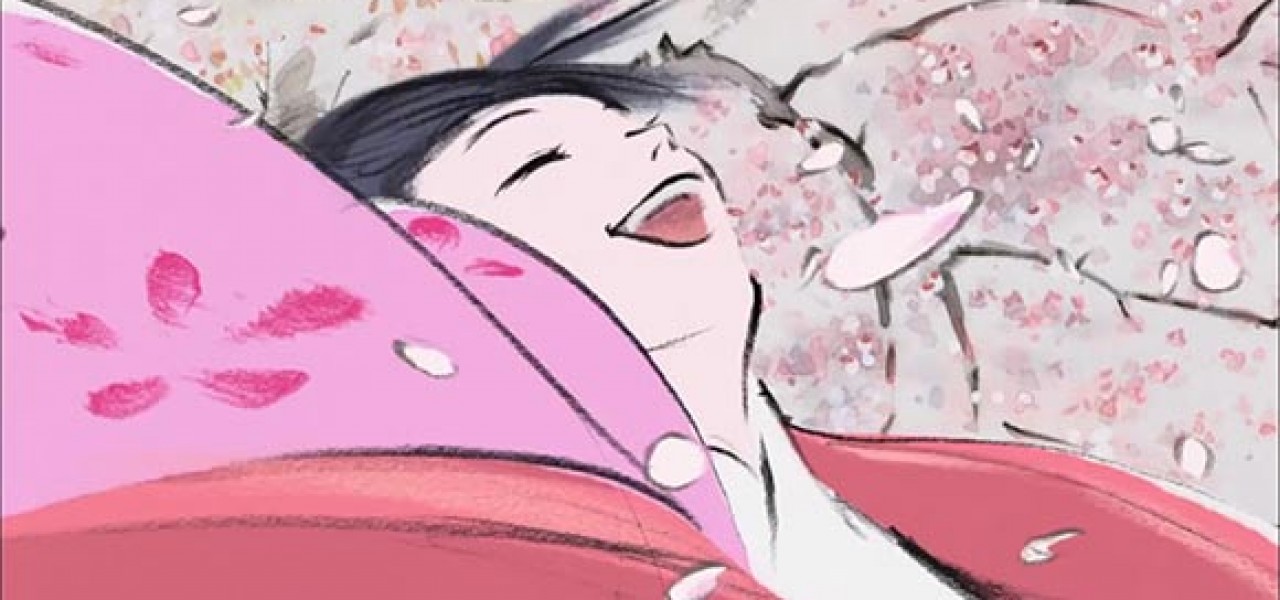
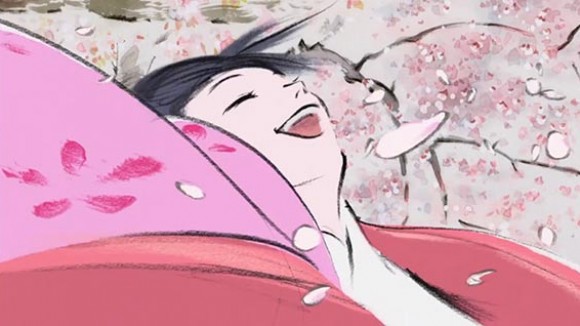
Oscar Ballot Guide: ‘The Tale of The Princess Kaguya’ Acting and Performance Analysis
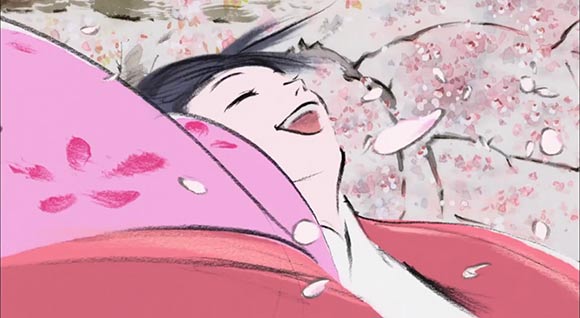
Series Introduction
The 2015 Oscar nominees for Best Animated Feature are, in alphabetical order: Big Hero 6, How to Train Your Dragon 2, Song of the Sea, The Boxtrolls, and The Tale of the Princess Kaguya. It’s an interesting and varied field, with a high level of craft on display throughout. Over the next two weeks, I will present a performance analysis for each of these films, beginning today with Isao Takahata’s hand-drawn film Princess Kaguya.
I am an acting teacher, not a movie reviewer, and my intended reader is the animation professional, not the general public. My goal is to help elevate the art of feature animation above merely commercial considerations. Box office grosses, no matter how impressive, are not a factor in my analyses. I am interested only in how a film works aesthetically—whether it is emotionally satisfying, cohesively expressed, and dynamically constructed. Where possible in these analyses, I will include thumbnail acting principles to illuminate particular comments or observations.
The Tale of the Princess Kaguya
Hayao Miyazaki was asked once during an interview what was the difference between his style of animation and animation in the West. He thought about it for a moment and then began to rhythmically clap his hands as he answered.
“When I clap my hands,” he said, “you hear the sound of the clap. You don’t hear what is in between the sound of the clap. In Japan, we have a name for what is in between the sound of the clap. We call it ma like ‘ma-ma.’” Miyazaki continued speaking, while clapping slowly: “Western animators are afraid of ma. They think you have to keep making the sound of the clap, or you will lose your audience. I disagree; I think if you fill ma with thinking, emotion and intention, you will not lose your audience.”
Studio Ghibli’s The Tale of the Princess Kaguya, based on a 10th century Japanese folk tale, has plenty of ma and the tale itself is incomplete, with hints of magic. Even after screening it several times, I still can’t tell you for certain why the character Li’l Bamboo shows up one morning as a thumb-sized child inside a freshly cut stalk of bamboo because director Isao Takahata is not explicit on the point. The character is just suddenly…there. The old bamboo cutter cuts a random stalk, and there she is, that’s all, a tiny beautiful jewel of a character. We in the audience are asked to willingly suspend our disbelief in such events, and so we do easily.
The principle of willingly suspending disbelief is an important one and is often abused in big Hollywood animated movies. An audience will go anywhere the storyteller asks it to, just as long as the rules for pretending are established up front. In Disney’s Pinocchio, for example, the movie opens on a cricket talking, singing, reading from a book, while wearing a dapper costume. We know perfectly well that crickets do none of these things in the real world, but the storyteller lets us know that this story is going to be one in which that kind of thing does happen. We go along with it, suspending our disbelief, and when the wooden puppet comes to life a few minutes later, we do not for an instant question the reality of it because the parameters of our suspension of disbelief were set up front, by Jiminy Cricket.
The Tale of the Princess Kaguya is clearly a folk tale. Humans do not hatch from bamboo stalks. Nonetheless, the storyteller is asking us to pretend that it is possible–just for the purposes of the tale being told. And so we do, happily, go along. In another film contending for an Oscar this year, How to Train Your Dragon 2, the suspension of disbelief is more complicated. We accept that there were pet dragons back in Viking days, but when Stoick finds Hiccup’s tiny helmet in the vast expanse of an uncharted icy ocean, we roll our eyes a bit because finding the helmet is too neat and tidy—a coincidence. There is no charm or artfulness in the finding of that helmet, only screenwriting expediency.
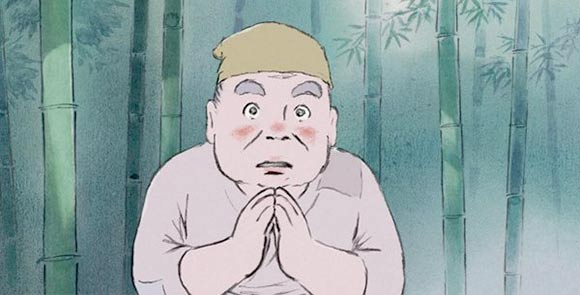
You have to be a grown-up to appreciate a children’s story like The Tale of the Princess Kaguya, and for better or worse, I personally fit the demographic. This is a story about paths not taken in life, about the simple wisdom of living fully in the present moment. Even though its title is The Tale of the Princess Kaguya, this is actually the old bamboo cutter’s story. Princess Kaguya’s appearance is the instigating event that leads the bamboo cutter to confront the Big Questions in Life.
There are images and moments in this film that have stayed with me days after watching it, When the bamboo cutter realizes that his adopted daughter is really leaving, he falls to his knees in bitter, flush-face, snot-running tears. (Timecode: 1:50:14 from the screener DVD.) Regret looks like that, and the moment made me cry, too, and still does if I even think of it.
This is what Shakespeare was talking about when he advised, in Hamlet, that “the actor hold up the mirror to nature.” Takahata is a great artist, and it is apparent from this single image. A lesser artist might have shown the bamboo cutter’s sadness with tears, but Takahata extended the action. As I explain in my acting classes for animators, emotion tends to lead to action, and the degree of the action is an artist’s expression. Tears alone would have communicated sadness and distress, but falling on his knees and copiously weeping like this is far more powerful. Good performance requires that the artist have courage as well as insight. Takahata could have gone too far when he pushed the impulse, but he did not. He was firmly in control of the moment, an artist in his world.
Let’s look at a few other specific sequences, analyzing them for performance:
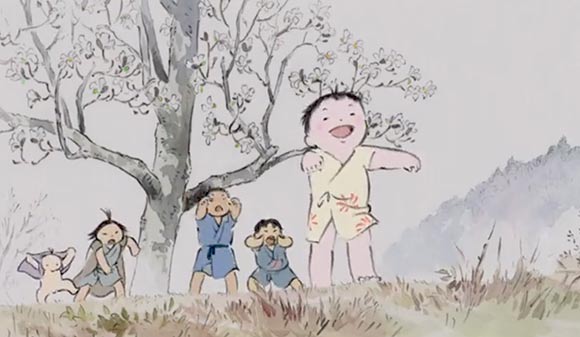
11:51 – 13:37 In this sequence, neighborhood kids are teasing the young girl, because she is growing so fast. It embarrasses her a bit, but the taunts set up the moment when the bamboo cutter comes to her defense. “Li’l Bamboo! Li’l Bamboo! Li’l Bamboo!” they chant. But the old bamboo cutter defends and protects her, reassuring her that she is a true princess. Again, the acting principle is that emotion tends to lead to action, so when the child jumps excitedly into the bamboo cutter’s protective embrace, we in the audience see the action and then, with empathy, look under the action to find the emotion that led to it. That is how empathy works in acting. We see what a character does, and then we look for the motivation. It all happens in a heartbeat, but you can see it if you slow down and investigate your own personal mental responses to good performance.
15:15 – 16:28 She stops in the woods to play with a litter of piglets and, when mama pig charges the intruder, the boy named Sutemaru rushes in and recues Li’l Bamboo just in time. A lifetime bond is formed that, in more ideal circumstances, would lead to marriage, children, and a life together. It is an innocent, sweet moment that is poignant in hindsight. Note, in particular, how emotion drives the entire sequence. Note Sutemaru’s urgency when he rushes in. That is a factor of emotion, not reasoning.
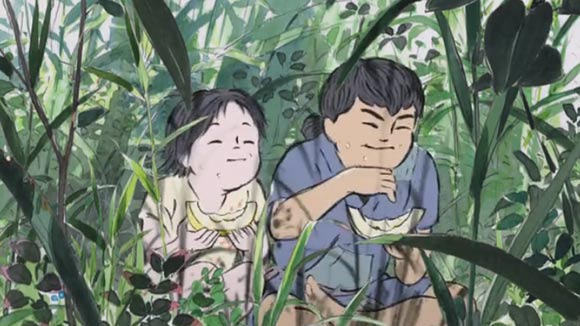
21:46 – 24:35 Li’l Bamboo unselfconsciously goes skinny dipping with her friends. Note how you, the audience, waits for Li’l Bamboo’s emotions after she is nude. Is she embarrassed? No. Many girls her age would be modest at this moment. We see something special about this character. Also, it is significant that she is totally nude. Takahata could have strategically covered her, and it was a pure artistic choice to have her stand nude for all to see. Later that day, she and Sutemaru steal a ripe melon from a local melon patch. They hide in the brush as he slices it up and they giggle and drool, enjoying one of the most delicious experiences in their young lives.
31:15 – 32:10 Without warning, her parents instruct Li’l Bamboo to leave her friends and carefree life and to come with them to the city. Disappointed and confused, she does what they ask her to do. Acting note: Observe the emotional transition. When she realizes she must abandon her friends, she is sad. The sadness is what leads to her rather wooden movement as she accompanies her parents. She is covering sadness; the covering itself is an action. In an instant, her life changes, and we arrive at the first major transitional moment in the movie. Note the change in the bamboo cutter’s posture as he adopts what he believes is upper-class carriage. He is calling all the shots in this life transition, with his wife and daughter following his lead.
40:39 – 43:08 Li’l Bamboo has her first menses, a sad moment for her, but an occasion of great joy and celebration for the bamboo cutter whose attention now shifts to finding for his daughter a wealthy and hopefully royal husband. Very nice performance animation here. The girl has mixed emotions about having her period. She realizes that she is a woman now, that time is passing, childhood is fading behind her. That is what causes her to eagerly suggest that she invite her old friends to the party. She is trying to hang on to childhood. A bittersweet moment that should resonate for all women. When her father rejects her suggestion with, “Don’t be a fool! We live in a different world to those hillbillies!” she realizes that a door has been violently slammed shut in her life.
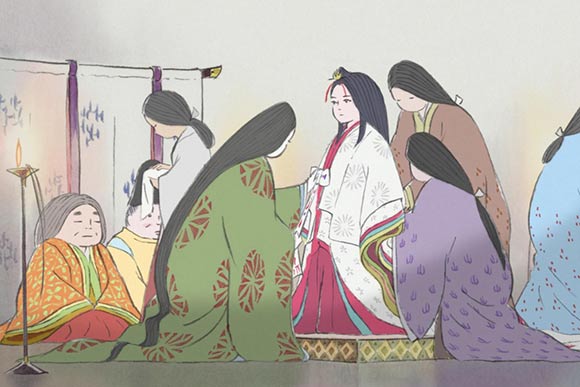
48:44 In this sequence, Li’l Bamboo, now formally re-named as the Princess Kaguya (“Shining Light”), seems to become a living—but literal—doll. They pluck her eyebrows, stain her teeth (“a fine lady does not open her mouth to laugh”) and dress her in exotic gowns. The life is going out of her as we watch. Acting note: Seeming to become a living doll is an acting choice. She does not want to fight it any more, even though she hates the idea of having her eyebrows plucked. When you see her so physically still, so compliant, that is an acting choice. Good acting does not necessarily equate to a lot of movement. If you think about it, some of the most important crossroad moments in your life have been quite still physically.
Five high-born men seek Princess Kaguya’s hand in marriage, and she rejects them all. The Emperor Mikado himself hears of this great beauty and courts her unsuccessfully. The movie feels overlong at times, and this is the reason why. If you have seen one thwarted, 10th century high-born suitor, you have seen them all. Isao Takahata respects his source material too much to tamper much with it, but in this case a couple high-born suitors, plus the Mikado, would have been more than sufficient.

1:47:10 Princess Kaguya tells her parents that she is leaving them soon, returning to the moon. It distresses her when the bamboo cutter tries to make her feel guilty about leaving, but she chooses not to engage with him on that level. “Everything we’ve done has been for your happiness,” he says tearfully. “That happiness you wished for me was hard to bear,” she replies, explaining that she prayed to the moon to save her. The acting note once again is that emotion tends to lead to action. And so, one final time, Li’l Bamboo reunites with Sutemaru who is now married with a child of his own. Seeking him out, going to his side, was a powerful acting choice. The easy thing would be to go on her way, leaving the Earth the way she found it. But all of us have an impulse to complete actions. It is in our nature that we put a final period on our activities when we can.
2:00:21 In a fantasy sequence, Li’l Bamboo and Sutemaru fly away. The final image of them together, before she falls permanently back into the orbit of the moon, is a fully-clothed but clearly intimate full-body lovers’ embrace, a wedding bed scene that is never to be. I recommend that you pause the film right there if you are watching it on a DVD. Pause it with them in loving embrace. Now…be honest: How do you feel?
These are just some of the sequences in Princess Kaguya that knock me out. It’s a stunningly beautiful piece of art that almost defies description and a film that I hope you will see. Isao Takahata is an animation master.
ED HOOKS is the author of Acting for Animators, (revised third edition, Routledge, 2011). Ed pioneered Acting for Animators in 1998 while working with the animators at PDI/DreamWorks in northern California, and teaches the Acting for Animators masterclass internationally. For Cartoon Brew, he previously wrote a performance analysis of Disney’s Frozen. For more information about his practice, visit EdHooks.com

